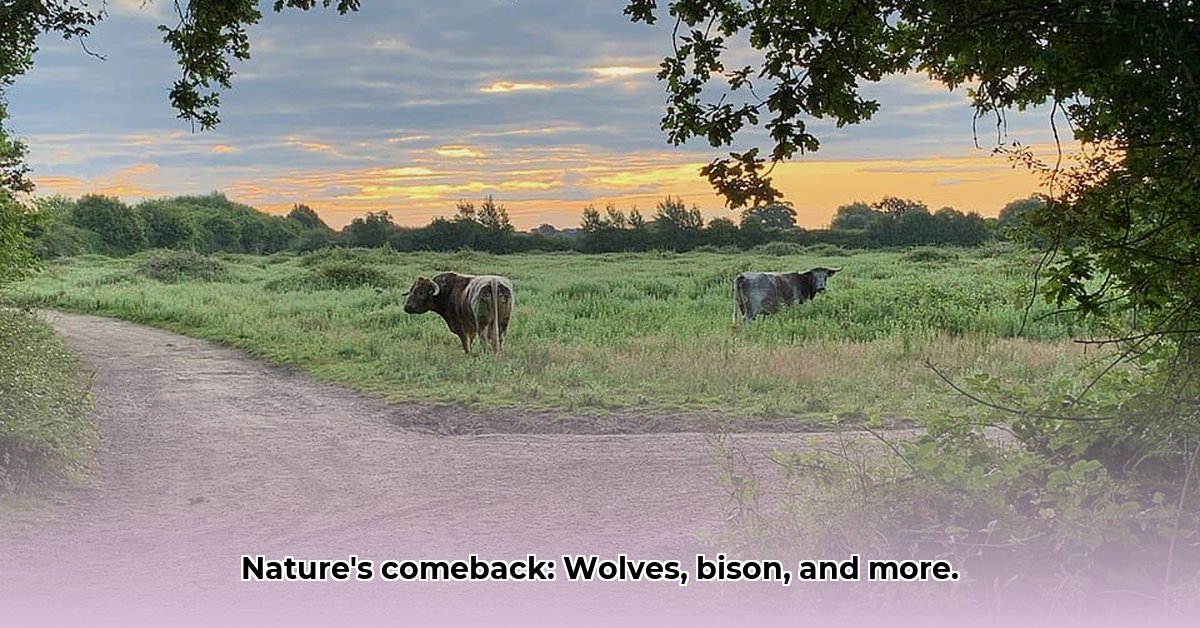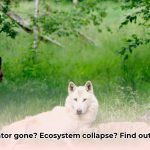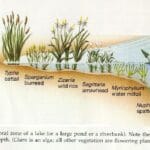Imagine vast landscapes where wolves roam freely and bison graze on sweeping grasslands. This vision, rooted in the concept of rewilding, is gaining momentum as a powerful approach to ecological restoration. Rewilding seeks to reinstate natural processes and biodiversity by reintroducing native species, often keystone predators and herbivores, and minimizing human intervention in designated areas. Learn more about the crucial role of keystone species here. However, this ambitious endeavor is far more complex than simply releasing animals into the wild. It requires a delicate balancing act, intertwining scientific understanding, community engagement, and adaptive management strategies. This article delves into the multifaceted world of rewilding, explores its ecological benefits and socio-economic challenges, and highlights the key strategies for fostering successful and sustainable projects.
The Essence of Rewilding: More Than Just Reintroduction
Rewilding goes beyond merely reintroducing charismatic megafauna like wolves and bison. It’s a holistic approach to ecosystem restoration that aims to reinstate natural processes and trophic interactions. The core principle is to allow nature to take the lead, enabling ecosystems to self-regulate and recover their inherent resilience. This involves identifying and addressing the underlying causes of ecosystem degradation, such as habitat fragmentation, overgrazing, and the absence of keystone species. By reintroducing missing elements and reducing human interference, rewilding sets the stage for a cascade of positive changes throughout the ecosystem.
Trophic Cascades: The Power of Keystone Species
The reintroduction of keystone species, particularly apex predators, triggers trophic cascades—a series of interconnected effects that ripple through the entire food web. Consider the iconic example of wolves in Yellowstone National Park. Before their reintroduction in 1995, the elk population had exploded due to the absence of natural predators, leading to overgrazing and a decline in riparian vegetation. However, the return of wolves dramatically altered the elk’s behavior and distribution. Wolves preyed on elk, reducing their numbers and prompting them to avoid open areas near rivers and streams. This, in turn, allowed willows, aspens, and cottonwoods to regenerate, stabilizing riverbanks and creating habitat for a variety of other species, including beavers, songbirds, and fish. This remarkable transformation demonstrates the profound influence of apex predators in shaping ecosystem structure and function.
Similarly, large herbivores like bison play a crucial role in maintaining grassland health. Their grazing habits prevent the encroachment of woody vegetation, promote plant diversity, and create a mosaic of habitats that support a wide range of insect, bird, and mammal species. Bison also contribute to nutrient cycling through their dung and urine, enriching the soil and enhancing plant growth. By restoring these natural grazing patterns, rewilding helps maintain the ecological integrity of grasslands and enhance their resilience to climate change.
Current research continues to illuminate the interconnectedness of species and the far-reaching impacts of rewilding. Studies are exploring the role of rewilding in carbon sequestration, biodiversity enhancement, and the restoration of ecosystem services such as pollination and water purification.
Navigating the Human Dimension: Challenges and Considerations
While the ecological benefits of rewilding are well-documented, the implementation of rewilding projects can be complex and challenging, particularly when it comes to navigating the human dimension. Reintroducing large predators and herbivores often raises concerns among local communities, particularly ranchers and farmers, who may worry about livestock depredation, crop damage, and potential threats to human safety. These concerns are legitimate and must be addressed through open communication, collaboration, and the implementation of effective conflict mitigation strategies.
The Oostvaardersplassen project in the Netherlands serves as a valuable case study in the challenges of rewilding. This ambitious project aimed to create a self-regulating ecosystem with minimal human intervention, introducing large herbivores to mimic the grazing patterns of extinct megafauna. However, the project faced widespread criticism when harsh winters led to mass starvation among the animals, highlighting the ethical dilemmas and public perception challenges associated with hands-off management approaches. The Oostvaardersplassen experience underscores the importance of adaptive management, where monitoring and intervention are necessary to prevent animal suffering and maintain ecosystem health. It also highlights the need for transparency, communication, and public engagement to build support for rewilding initiatives.
Building Bridges: Fostering Community Engagement and Collaboration
Successful rewilding projects depend on forging strong partnerships with local communities and stakeholders. This requires building trust, fostering open communication, and creating opportunities for collaboration. Community engagement should begin at the earliest stages of project planning and continue throughout the implementation process. Local knowledge and perspectives are invaluable in identifying potential challenges and developing effective solutions.
One of the most effective ways to build community support for rewilding is to demonstrate the potential economic benefits. Rewilding can create opportunities for ecotourism, nature-based recreation, and sustainable agriculture, generating income and jobs for local communities. For example, in Romania’s Carpathian Mountains, the reintroduction of European bison has revitalized local economies by attracting tourists and creating new employment opportunities in wildlife monitoring, guiding, and hospitality.
In addition to economic benefits, rewilding can also provide ecosystem services that benefit local communities, such as improved water quality, flood control, and pollination. By showcasing these tangible benefits, rewilding projects can demonstrate their value to local communities and build long-term support.
The Legal and Policy Landscape: Creating an Enabling Environment
Government policies and legal frameworks play a crucial role in shaping the success of rewilding initiatives. Supportive policies can provide incentives for landowners to participate in rewilding projects, protect rewilded areas from development, and promote sustainable land management practices. Clear and well-enforced regulations are also essential for managing human-wildlife conflict and ensuring the long-term viability of rewilding projects.
In the United States, the Endangered Species Act has been instrumental in the recovery of several keystone species, including wolves and bison, paving the way for rewilding efforts in many parts of the country. However, the legal status of these species remains contested in some areas, highlighting the need for ongoing advocacy and policy reforms to ensure their continued protection.
Internationally, the Convention on Biological Diversity provides a framework for countries to conserve and restore biodiversity, including through rewilding. However, the implementation of this framework varies widely across countries, and greater international cooperation is needed to promote rewilding as a key strategy for achieving global conservation goals.
Charting a Path Forward: Actionable Strategies for Success
Rewilding is a continuous journey, demanding constant learning and strategy refinement. The ultimate vision is a future where dynamic natural landscapes and thriving communities coexist, fostering a world abundant in both biodiversity and opportunities.
| Stakeholder Group | Short-Term Actions | Long-Term Strategies |
|---|---|---|
| Government Agencies | Fund scientific research; develop adaptive regulations; provide financial aid for damages from wildlife. | Invest in habitat restoration; incentivize landowners; promote community-based conservation. |
| Conservation NGOs | Boost community involvement; create educational programs; advocate for supportive policies. | Foster partnerships; develop capacity; promote sustainable practices. |
| Local Communities | Actively engage in project planning; explore economic opportunities; openly voice concerns. | Build sustainable livelihoods; nurture trust and communal ownership; address conflicts equitably. |
| Landowners | Investigate coexistence strategies; engage in discussions; seek financial and technical assistance. | Develop innovative land management techniques; fuse conservation with economic gains; gain support and training. |
| Scientists | Monitor ecological impacts; develop conflict mitigation; share knowledge widely. | Conduct long-term research; assess socio-economic impacts; advise policy decisions. |
Mitigating Human-Wildlife Conflict in Rewilding: A Proactive Approach
Rewilding endeavors, essential for large-scale ecological restoration, often entail the reintroduction of keystone species such as wolves and bison. While ecologically advantageous, these initiatives can spark discord with human interests, notably regarding livestock predation by wolves or the disturbance of agricultural practices by bison. These challenges prompt critical inquiries: How can we harmonize ecological objectives with human necessities? How do we ensure rewilding benefits both the environment and local populations?
Understanding Conflict Origins
Human-wildlife conflicts arise from diverse sources. Habitat overlap is a key contributor; as wildlife populations rebound, interactions with humans intensify. Economic repercussions also play a pivotal role, as farmers may suffer livestock losses to predators while tourism-related businesses might substantially gain. Contrasting values and wildlife perceptions introduce further complexity: An animal viewed as majestic by one person might be perceived as a menace by another.
Multifaceted Mitigation Strategies
How to mitigate human-wildlife conflict in rewilding projects requires a proactive, multifaceted approach:
- Early Community Engagement: Initiate relationship-building with local communities before launching rewilding efforts. Involve open dialogue and transparent communication.
- Non-Lethal Deterrents: Employ non-lethal methods to deter wildlife from human areas, such as fencing, guard animals, or aversive conditioning.
- Compensation Programs: Establish equitable and timely compensation for wildlife-induced losses or damages.
- Education and Awareness: Implement extensive education to enhance public understanding of rewilding benefits, and teach coexistence strategies.
- Monitoring and Evaluation: Monitor human-wildlife interactions and collect conflict data to refine management.
- Collaborative Management: Integrate local communities and stakeholders into management decisions to foster trust and ownership.
- Legal Framework & Policy: Align the project with legal and policy parameters for transparent conflict resolution.
Case Study: Oostvaardersplassen
The Oostvaardersplassen Nature Reserve in the Netherlands exemplifies the repercussions when ecological priorities overshadow socio-political considerations, leading to adverse outcomes for both wildlife and communities.
Sharing a Future: Synergizing Rewilding with Human Needs
Incorporating rewilding into inhabited landscapes requires more than ecological restoration—it necessitates a dedication to community involvement, conflict mitigation, and benefit-sharing. The ultimate goal is harmonious coexistence between wildlife and thriving human communities.
Source 1: Legacy Landscapes Report
The Rewilding Renaissance: Restoring Ecosystems, Engaging Communities
Key Takeaways:
- Rewilding yields substantial ecological gains, including enhanced biodiversity and improved ecosystem functionality.
- Keystone species reintroduction sets off trophic cascades, revitalizing ecosystems.
- Successful ventures need careful planning, community participation, and effective management.
- Balancing ecological restoration with community needs ensures project success.
- Human-wildlife conflict resolution and funding sustainability are ongoing challenges.
The Rewilding Symphony
Rewilding involves restoring missing instruments (keystone species) to reinstate ecosystem harmony. Wolf reintroduction reshapes landscapes by curbing deer populations and fostering vegetation recovery. Bison grazing revitalizes grasslands, and enhances carbon sequestration.
Navigating the Human Element
Rewilding’s success hinges on effective communication and engagement with communities, as integrating apex predators can raise economic concerns. The Oostvaardersplassen case underscores the necessity of reconciling wildlife needs with human concerns through engagement.
Key is Community Collaboration
Inclusivity through discussion, transparency, and benefit-sharing ensures community immersion in every project phase.
The Legalities of Rewilding
Government support is vital to create policy that protects rewilded areas, manages human-wildlife interactions, and provides enduring research and monitoring funding.
A Call to Action
| Stakeholder Group | Short-Term Actions | Long-Term Actions |
|---|---|---|
| Conservationists | Launch small-scale projects; prioritize keystone species. | Secure funding; establish extensive, interlinked rewilding areas. |
| Governments | Invest in research; foster supportive policies. | Incorporate rewilding into conservation strategies. |
| Local Communities | Participate in planning; address concerns about wildlife. | Cultivate economies tied to rewilding. |
| Scientists | Monitor ecosystems; refine predictive models. | Bridge knowledge divides; formulate adaptive management strategies. |
Proven Rewilding Tactics: A Strategic Approach
Key Takeaways:
- Harnessing the interplay between ecosystems and socio-economic frameworks is vital.
- Proven Tactics For Successful Rewilding Initiatives entail precise species selection, adaptive management, community engagement, and firm policies.
- Keystone species reintroduction triggers beneficial trophic cascades, but community impacts need mitigation.
- Sustainable funding, continuous monitoring, and public backing are crucial for viability.
- Adaptive management is essential.
Ecological Ripple Effects
Rewilding involves reintroducing keystone species, triggering cascading effects like reduced elk grazing by wolves in Yellowstone, thus allowing riparian vegetation to flourish.
Socio-Political Approaches
Social and political landscapes present complexities. Human-wildlife conflict requires adaptive management techniques, like in the Oostvaardersplassen project, to deal with mass animal deaths during winters.
Keys to Community Engagement
Rewilding relies on collaboration, integrating traditional ecological knowledge, addressing local concerns, and creating opportunities for benefit-sharing.
Setting the Rewilding Stage
Policies and legislation are vital to ensure governmental support, research funding, and tools to mitigate human-wildlife conflict.
Actionable Steps for Success
| Stakeholder Group | Short-Term Actions | Long-Term Actions |
|---|---|---|
| Government Agencies | Fund research, enact conflict-mitigation | Invest in habitat restoration, establish protected areas. |
| Conservation Organizations | Enact community engagement, collaborative partnerships | Develop innovative funding, champion policy changes. |
| Local Communities | Engage in planning, address human-wildlife challenges | Secure enduring economic gains, foster community initiatives. |
| Researchers | Monitor projects, analyze impacts, create models | Share practices, communicate findings. |
These are vital components of Proven Tactics For Successful Rewilding Initiatives.
- The Accidental Breakthrough: Penicillin’s Discovery and Impact - August 1, 2025
- Medieval Universities: Shaping Modern Academia - August 1, 2025
- The Radium Girls: Workplace Safety Lessons from a Tragic Past - August 1, 2025
















